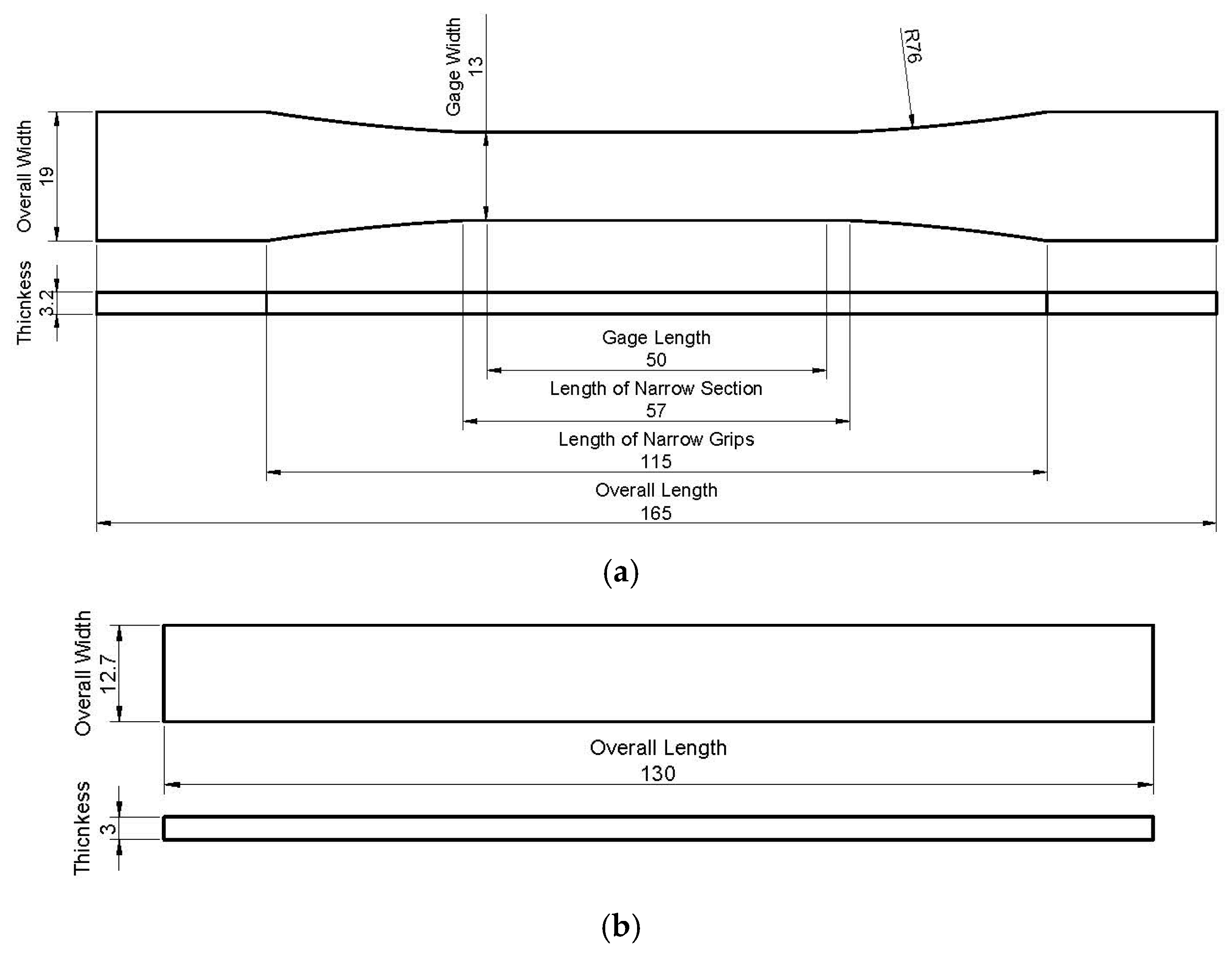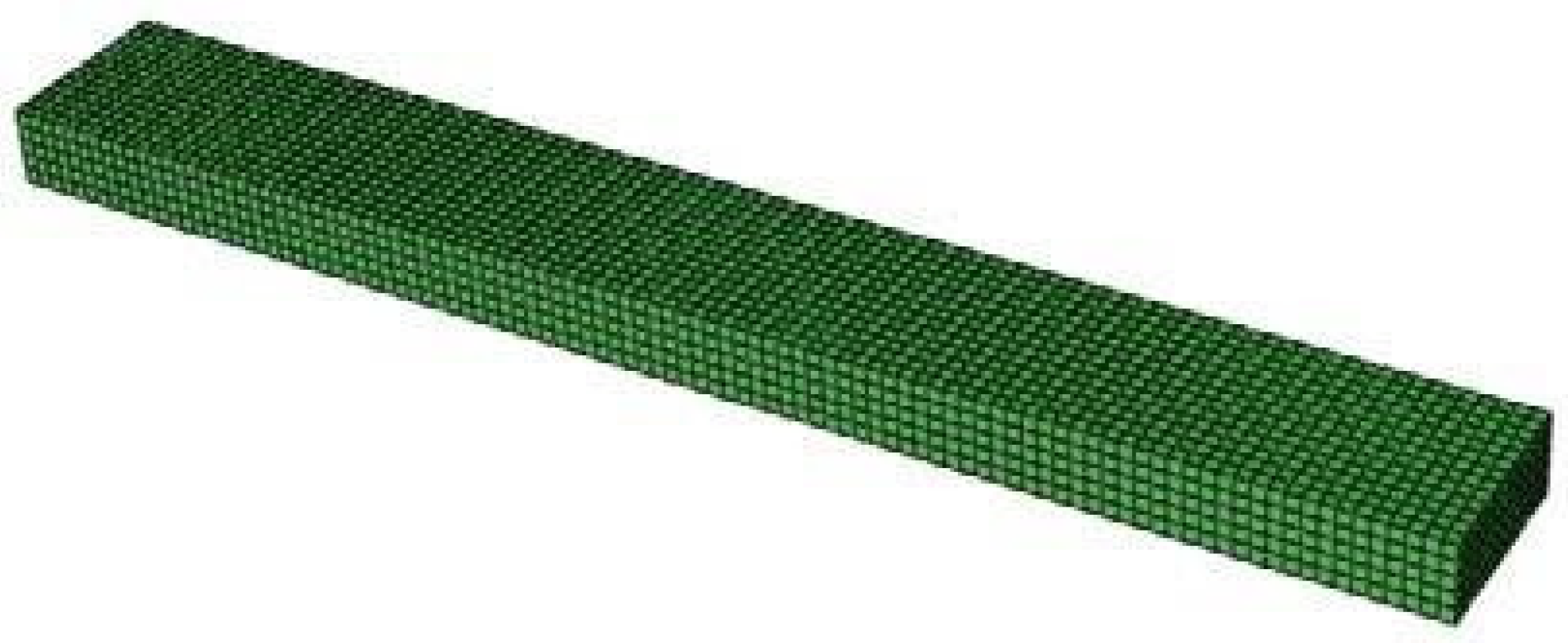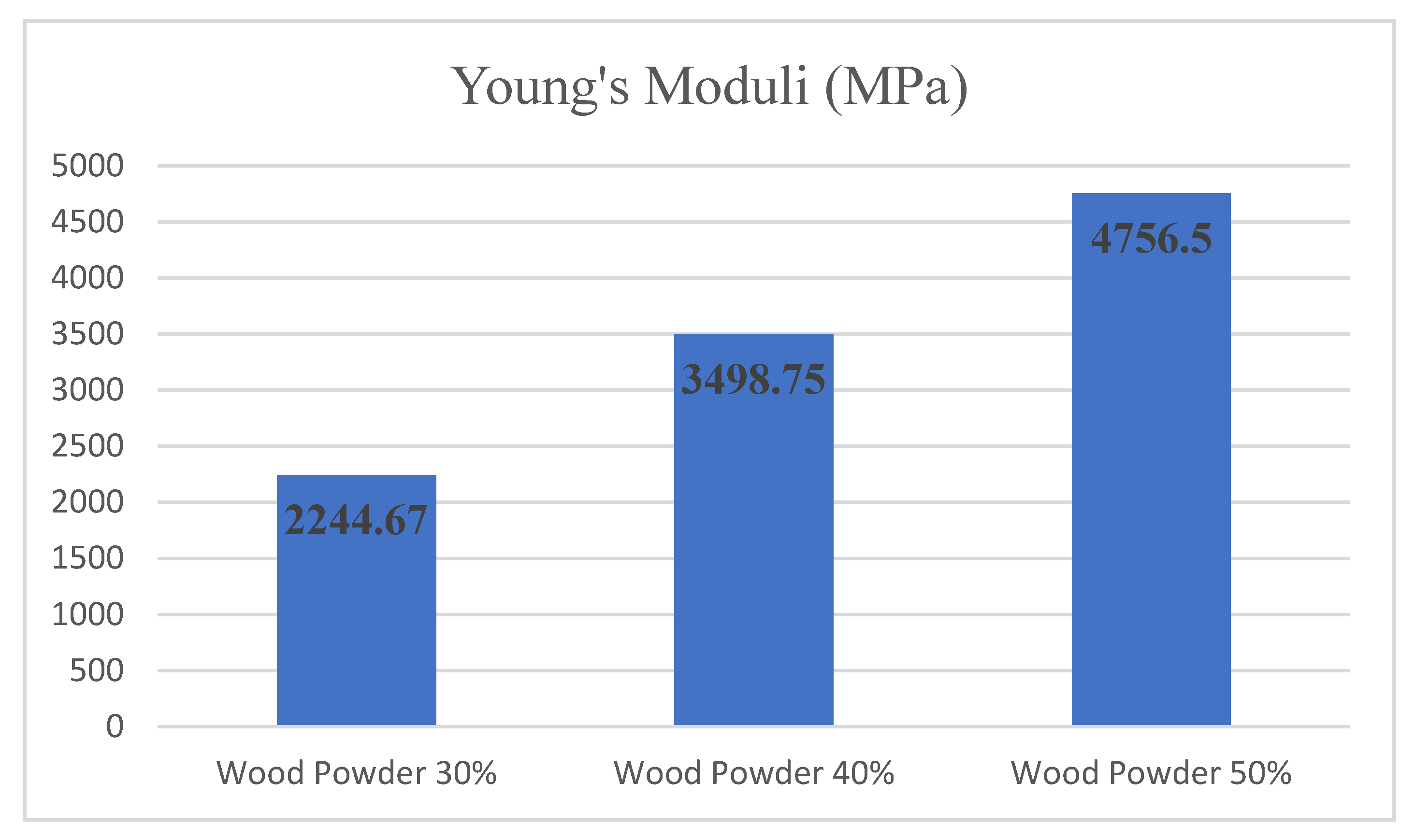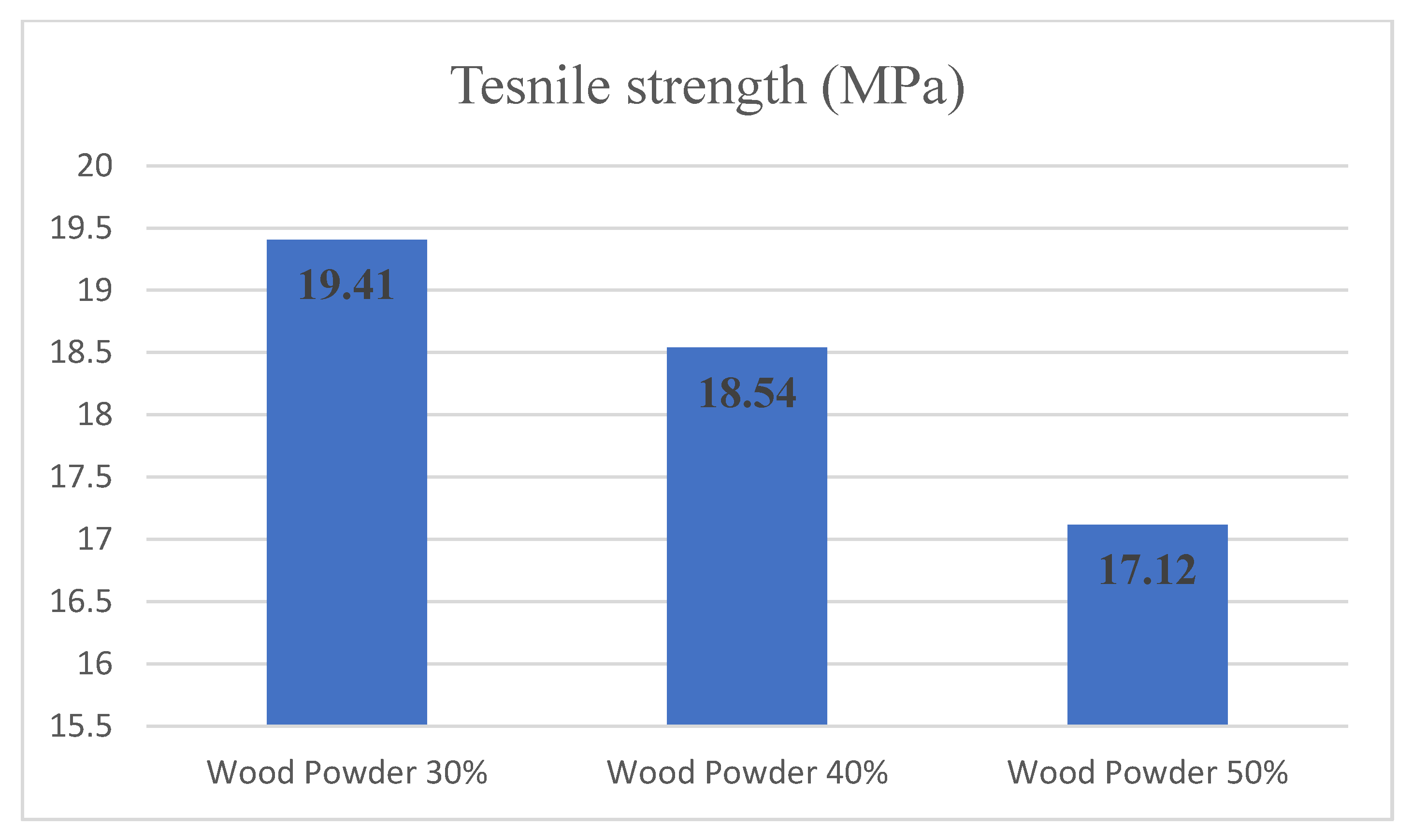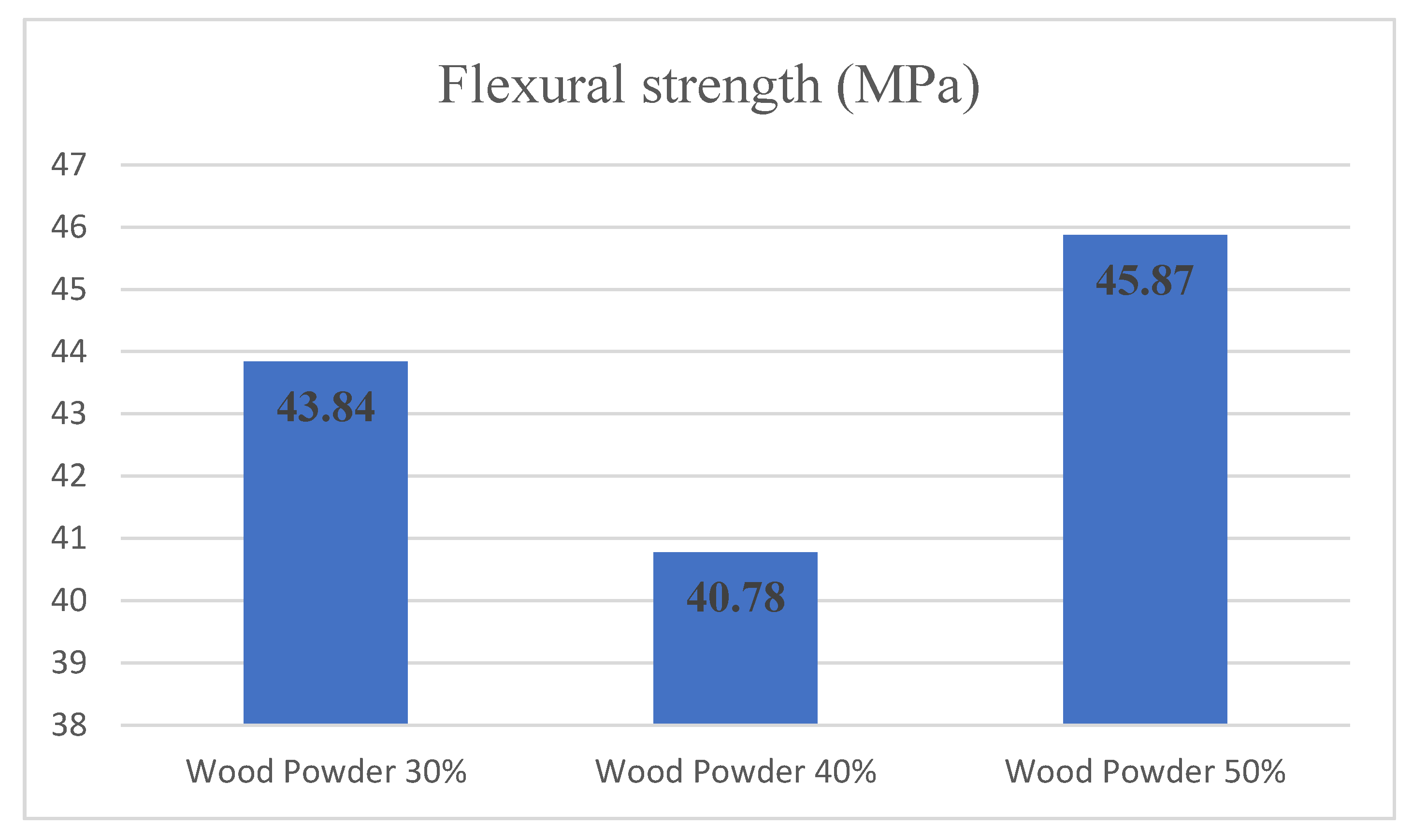1. Introduction
Wood-plastic composite (WPC) is a promising and sustainable green material with similar properties to wood but with better water resistance and characterized by satisfactory stability of properties in many environments [
1,
2]. In the WPCs, the filler comprises waste wood in various forms, such as chips, sawdust, shavings, splinters, or the most common, wood flour. Due to the unique combination of polymer and wood properties and their attractive appearance, WPCs have become an interesting alternative for both polymers and wood industry products [
3]. Their main advantage is using the same processing tools as their natural counterpart, wood [
4].
According to the thermoplastic matrix, these composites can be used where natural wood does not meet the conditions necessary for its operation due to its resistance to water and biological corrosion [
5,
6]. Simultaneously, using a thermoplastic matrix allows them to be processed with classical polymer processing methods, which has a beneficial effect on production. Polyethene (PE), polypropylene (PP), and polyvinyl chloride (PVC) are usually used as the WPC matrix.
Another significant advantage of WPCs is that they have unique properties derived from combining the beneficial characteristics of wood and thermoplastic. Polymer composites filled with wood flour present favorable mechanical properties and higher stiffness compared to unfilled polymer materials [
7]. Furthermore, compared with wood and wood-based materials, they are characterized by much lower water absorption and resistance to external (e.g., atmospheric) factors [
8]. Moreover, applying waste wood materials as fillers for WPC is very favorable for ecological reasons. They are not a hazard to the natural environment during processing and recycling processes. Additionally, after proper modification, WPCs become partially biodegradable [
9,
10].
Moreover, the improvement of WPCs’ development can be achieved with nanoscience and nanotechnology. The use of nanosized fillers in WPC production can improve their mechanical and physical properties [
11]. Depending on the expected properties, the types of nanofillers can be chosen. The most popular nanoclays are obtained from layered silicates. This nanosized filler usage can improve flexural and tensile strength and decrease water absorbance [
12]. These properties can be significantly enhanced by increasing the interfacial area of polymer and wood flour. The particle size of nanoclays is less than 2 microns.
What is more, a small quantity of nanoclays can increase the mechanical properties of the composite. Nanoclays, with their high aspect ratio and nanometer size, provide increased particle–particle and polymer–particle interactions compared to traditional fillers [
13]. Additionally, the addition of nanofiller in the composite decreases thickness swelling and water absorption.
Polymer nanocomposites provide additional properties with low filling (3–5 wt.% on average, max. 10 wt.%). This allows maintaining all the advantages of the original composite simultaneously. The essential benefits of nanoparticles in WPC production are increased stiffness without loss of impact strength, dimensional stability, improvement of the barrier effect, and reduced surface defects of products [
14].
Sharma et al. [
15] conducted a polymer-based composite with glass fiber and nanoclay reinforcements. They found that by increasing the amount of nanoclay up to 3%, tensile strength increased, and by adding nanoclay more than 3%, the strength decreased.
Islam et al. [
16] reinforced the epoxy matrix with carbon nanotubes and nanoclay. After preparing the samples, a bending test was performed. The results of this experiment showed that the flexural strength is improved by adding nanoparticles. According to the impact test, it could be concluded that the samples reinforced with nanoparticles can absorb more energy than the control samples.
In a study, Deepak et al. [
17] investigated the effect of using coconut shell and nanoclay as a reinforcing material in polyester. The results show that by increasing nanoclay, tensile strength, impact energy, and compressive strength increase.
Zunjarrao et al. [
18] investigated the effect of nano- and micro-sized aluminum particles as reinforcements in the epoxy matrix. Failure test for three different samples of pure epoxy, particle-reinforced epoxy 20–100 μm, and epoxy reinforced with particles of 3–4.5 μm were conducted. Observations show that with the addition of particles to the epoxy, the toughness increases. The toughness of epoxy reinforced with particles of 20–100 μm is higher than that of epoxy with particles of 3–4.5 μm. Failure occurs at higher loads in both specimens, but this improvement is more significant for 3–4.5 μm particles than 20–100 μm.
In a study conducted by Srinivasa et al. [
19], arka fruit peel was placed in the epoxy matrix as a reinforcing material. An impact test was performed on the specimens. Each sample was tested five times, and the average of the five tests was considered. The results of this experiment show that the strength of composites increases with increasing component volume.
Plastics have low strength due to their low Young’s modulus, but their applications are very wide. The main advantages of plastic materials are their low weight and applicability for high humidity environment. On the other hand, wood powder as reinforcement is a relatively cheap material. Its use is very extensive, as shown in the cited articles. Creating a composite from these two materials gives an excellent application in various engineering fields. Unfortunately, like each of the composite materials, its physical and mechanical properties are varied in the context of the different content of individual materials. Additionally, one of the newest solutions to strengthen materials is nanoparticles, e.g., nanoclay. The additional reinforcement resulting from the different content of these molecules strengthens the final material to some point. Therefore, the main objective of this paper is to investigate the mechanical properties of WPC containing different amounts of wood powder and strengthened with nanoparticles. Additionally, numerical analysis was performed to evaluate the experimental results. What is more, the mechanical properties of WPC containing different amounts of wood powder are given. Moreover, this research could influence the design of WPC products, considering the increase of mechanical and physical properties.
2. Materials and Methods
2.1. Materials
In this research, the matrix material is heavy polyethylene prepared from Arak Petrochemical Trading Company (Tehran, Iran) with code 5218 and a melt flow index of 18 g/10 min, the specifications of which are given in
Table 1.
The nanoclay used for the preparation of the specimens was prepared by Sigma-Aldrich company (Munich, Germany). The characteristics of the nanoclay are summarized in
Table 2. Narad wood flour was used as a wood powder in the polymer matrix. Kian Choob Company (Tehran, Iran) prepared the wood flour. The wood flour was classified using a vibrating sieve to uniform the particle size and reach the desired size. Firwood flour, which passed through 60 mesh, and the rest on a sieve with 80 mesh, was considered flour. The samples were then placed in an oven at 100 °C for 24 h to dry.
The coupling agent maleic anhydride was used. Its specifications are presented in
Table 3.
2.2. Preparation of Wood-Plastic Composite
The mixing process was performed using the internal mixer HBI System 90 made by the American company Haake Buchler (New Jersey, NJ, USA). A mixing temperature of 170 °C and mixing speed of 60 RPM were used. The total mixing time until reaching constant torque was 10 min. First, polyethylene was poured into the device’s housing, and after melting for 2 min and reaching constant torque, maleic and nanoclay were added. After 5 min, flour was added. The wood was poured into the chamber, and the mixing operation was carried out continuously until a constant torque was reached.
After cooling and hardening, the material was granulated using the Wieser WG-Ls 200 semi-industrial shredder (Wieser Company, Hamburg, Germany). The compounds of each specimen are shown in
Table 4.
The granules were then transferred to an injection molding machine to make standard test specimens. For this purpose, a semi-industrial injection machine made by Imen Machine Company (Tehran, Iran) of Tehran was used. The injection cylinder temperature in each region was 155, 165 and 175 °C. The injection pressure was 100 MPa and lasted for less than 75 s. The mold was cooled with cold water, and the samples were taken out of the mold after 2 min. The injection mold was designed so that the specimen, according to ASTM D638-02A [
20] and ASTM D790-02 [
21] standards, for tensile, bending, and impact tests were obtained.
Figure 1 shows a sample taken out of the mold.
Figure 1a presents the specimen for the tensile test, and
Figure 1b shows the bending test sample. Additionally,
Figure 2a,b show the dimensions of samples for the tensile and bending test, respectively.
2.3. Mechanical Testing
To evaluate the mechanical properties of wood-plastic composite, the tensile and bending test, according to ASTM D638-02A and ASTM D790-02, respectively, were performed. The experimental tests of specimens were done on the testing device Instron 4486 at room temperature. All tensile and bending tests were conducted applying a 500 N load cell. What is more, the crosshead speed moved at 2 mm/min. All performed mechanical testing of each sample composition was performed no fewer than five times, and the mean values were computed and taken into consideration. According to obtained force-displacement curves, the calculations were performed to obtain tensile strength, flexural strength, and Young’s moduli. Additionally, to calculate the Poisson’s ratios, the two-way TML strain gauge was installed on the test specimens. Measurement with this device allowed to the calculation of the Poisson’s ratios.
2.4. Statistical Analysis
In this study, SPSS 24 software (24.0, IBM Corp., Armonk, NY, USA) was used. Statistical analysis of data was performed using variance analysis and comparison of mean values using Duncan’s test. The variable factor’s effect on the studied properties was investigated at a 95% confidence level (5% significance level).
2.5. Numerical Analysis
2.5.1. Tensile Test Simulation
The WPC specimen was modeled following the shape and dimensions of the ASTM D638-02A standard in Abaqus software version 6.14.1 (Dassault Systemes, ABAQUS Inc., Waltham, MA, USA).
The properties of two-phase elastic and plastic materials for the wood-plastic composite were considered. In the linear-elastic region, the material was deemed to be isotropic. The Young’s modulus and Poisson’s coefficient were entered for each sample’s according to
Table 5. Then plastic behavior was modeled. First, the yield stress and plastic strain zero value were entered as the plastic strain corresponding to the yield stress to define the plastic region’s material properties. Then, in the next row, the stress greater than the yield stress and the corresponding plastic strain was entered.
The boundary conditions of one side of the specimen at the device’s fixed grip was motionless, and the other side could move in a neutral axis direction. Mesh size was selected as 1 mm. The model was prepared only for half of the specimen because of symmetry. Finally, the sample was aligned with the hexagonal elements in a regular and uniform form. Then, the analysis was performed with Abaqus software.
Figure 3 shows the meshed specimen for the numerical tensile test.
2.5.2. Bending Test Simulation
The WPC specimen was modeled following the shape and dimensions of ASTM D790-02 standard in Abaqus software version 6.14.1. The mechanical properties of each specimen are considered, according to
Table 5. One of the grips was deemed immobile for the boundary conditions, and the second grip was movable only vertically. Then, two supports and a load-applying device, which are cylindrical, were modeled. The contact of the upper grip with the sample surface was defined in the interaction module with the surface-to-surface mode. Then, using a rigid body constraint, the lower supporting grips and the upper movable grip were modeled as rigid, and their movement was limited to the movement of a point. In the loading module and in the boundary condition section, the lower supporting grips, whose movement was limited to one point, were considered immobile. The numerical value of the upper movable grip displacement was entered. The amount of movable grip displacement is obtained from the experimental test. The mesh size of 1 mm was finally selected. The hexagonal elements in regular and uniformed form were assigned.
Figure 4 shows a modeled specimen for a bending test.
4. Discussion
The Young’s moduli increase in nanofiller composites is directly related to the average length of clay particles and their dimensional ratio. Various structural factors such as volume ratio, nanoclay aspect ratio, particle spacing, and the amount of nanofiller particle cracking have a significant effect on the mechanical properties of clay-polymer composites. Additionally, the difference between the degree of swelling of the layers and the layer structure formation strongly affects the nanoclay composite’s elasticity modulus. Besides, the percentage of nanofiller in composites plays a significant role, usually increasing the mechanical properties with the percentage of nanoclay [
22]. However, after a specific limit, the increasing trend of properties stops or even decreases with the increment of the nanofiller particles [
23].
Increasing the nanoclay, interlayer, and layer morphology in the nanofiller composite, due to the interfacial effect of organic chains and nanoclay particles and the orientation of layered silicate particles, increases the strength of the nanofiller composite. Additionally, the heterogeneity and high surface-to-volume ratio of nanoclay with organic matter contribute to the high-reinforcing capacity of nanofiller particles. It is done so that nanoparticles as a reinforcer causes the joint surface between two phases. As a result of swelling of the clay layers and strong adhesion between the polymer and the clay, the composite increases in strength [
24]. Therefore, nanoparticles increase the tensile and flexural strength of WPC [
25].
The coupling agent’s percentage increases the joint strength between the two phases of cellulosic and polymer. In other words, the use of a coupling agent creates a more homogeneous structure in the composite. It causes a better stress distribution during the application of static load. Less stress concentration will occur in one area of the material, increasing stress-bearing capacity and flexural strength. To effectively transfer the stress and distribute the load correctly, it must have a strong connection at the two phases’ joint surface. Without a coupling agent, nanofiller particles are present as separate components with weak bonds within the substrate. Therefore, they cannot participate effectively in the stress distribution [
26,
27].
Since the amount of wood particles added increases the modulus of elasticity in all three levels, and as lignocellulosic materials have a higher modulus of elasticity, so the value of Young’s moduli of the composite material increases with the addition of wood flour to polyethylene [
28]. The modulus increase indicates a decrease in the composite material’s deformation under load, which is a positive factor in engineering structures that must withstand a large load without deformation [
29]. Therefore, increasing the modulus of elasticity concerning the relationship E = σ/ɛ and decreasing the samples’ strain by increasing the amount of wood flour can also be justified.
In WPC, with high numbers of fibers, the matrix has the role of adhesive for bonding wood particles to each other [
30]. This leads to a mechanical bond between the wood and polymer particles. Lack of chemical bonding is due to plastic’s non-polar nature and wood fibers’ polar nature [
31]. The volume of wood powder in the polyethylene leads to the polymer’s cracking and reduces strain. On the other hand, with more wood flour, the strain values have been significantly reduced. Therefore, according to the relation Eɛ = σ, the value of the modulus of elasticity increased, causing a sharp decrease in the value of strain and reduced tensile strength.
Furthermore, the mechanical test was simulated using Abaqus software. The results indicate a difference between the failure force’s values from the experimental test and numerical analysis. This difference may be due to the test sample’s adjustment in the device’s grips. This situation is minimized when closing the specimens, but it does not disappear completely. However, in software simulation, the problem is entirely ideal. Furthermore, in theory, and numerical simulation, the model is created as a continuous medium. In other words, the whole body is filled with material particles. In the experimental part, voids filled with oxygen may arise during the molding process, providing different results, such as fracture force. What is more, when the WPCs matrix exceeds its maximum capacity, cracks will appear. This effect will decrease the stiffness of the whole material and contribute to the difference between experimental and numerical results. More importantly, as we used fixtures to do the mechanical tests, some loss between jaws and the part existed. However, the part modeled in the FEM software is entirely fixed, and this discrepancy can result in some differences in the numerical results of experimental vis-à-vis FEM.

